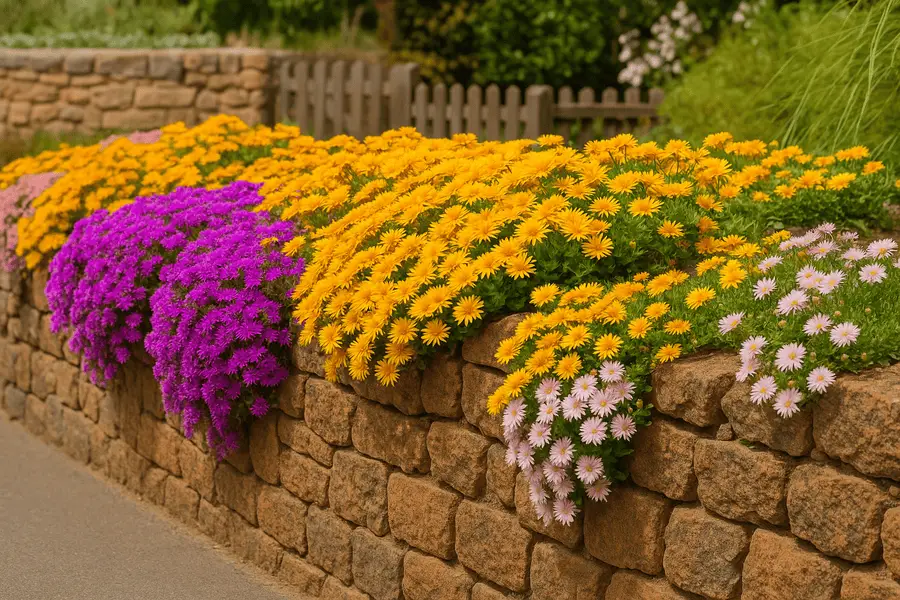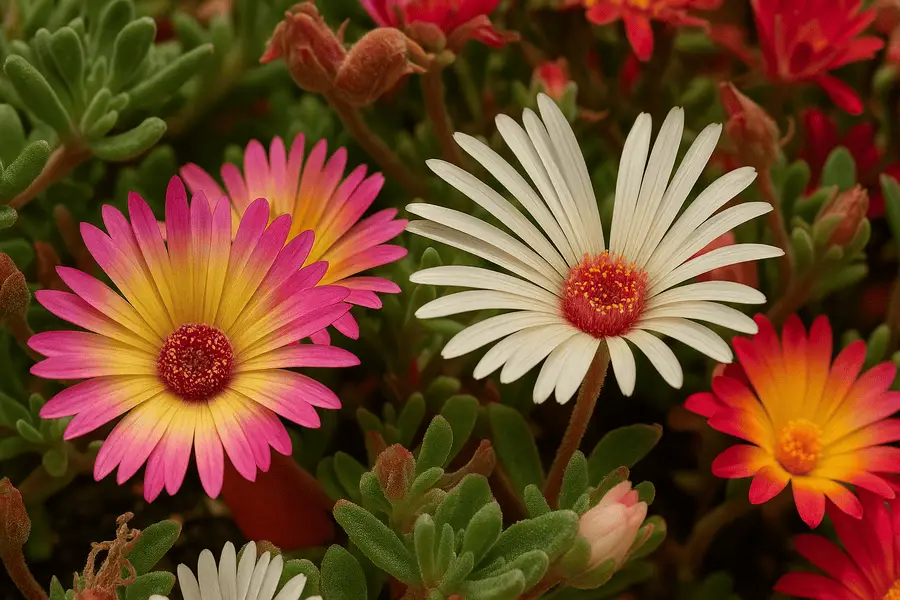
Ice Plant Ground Cover is your secret weapon for transforming dry, boring spots into a carpet of bright, cheerful blooms.
If you’ve struggled with thirsty plants that just can’t handle the heat, it’s time for a switch.
These little beauties thrive in tough conditions and bring color that pops, all with hardly any upkeep.
Ice Plants (Delosperma) add bold color to dry spots, thrive in full sun, and spread fast with barely any maintenance needed.
Ice Plant Ground Cover Key Takeaways
- Ice Plant Ground Cover is a drought-tolerant succulent that forms a dense, colorful mat of daisy-like flowers.
- It thrives in full sun, spreads quickly, and requires little water once established.
- Perfect for slopes, rock gardens, and xeriscapes, it’s an easy-care choice for vibrant, low-maintenance landscaping.
Ice Plant Ground Cover: A Cut Above for Xeriscapes
Ice Plant for Xeriscapes brings the kind of bold color and easy-care charm your dry garden has been missing.
If you’re tired of crispy lawns or dull patches that won’t grow, this plant’s your answer.
It spreads fast, blooms bright, and handles heat like a champ, all with barely any water.
🌵 Why Ice Plant Is a Game-Changer
A dry, dusty yard can make your whole space feel lifeless and tough to manage.
You water, you wait, and still, nothing but sad soil and struggle. That’s where an Ice Plant Ground Cover steps in.
It adds a burst of color, spreads like magic, and thrives with barely a sip of water. Now that’s a smart swap.
🌼 What Is an Ice Plant?

Ice Plant is the common name for a group of low-growing, sun-loving succulents that light up your yard with daisy-like blooms.
While there are several types, this post focuses mainly on Delosperma, one of the most cold-hardy and popular varieties for xeriscaping.
❄️ Why Is It Called Ice Plant?
The name “Ice Plant” comes from the way some species look like they’ve been touched by frost.
Tiny, shimmering cells on the leaves and stems reflect sunlight, giving the plant a frosty, glittering appearance almost like it’s covered in ice crystals.
It’s not cold to the touch, but it sure brings a cool vibe to hot, dry spaces!
Delosperma cooperi
Delosperma cooperi (syn. Mesembryanthemum cooperi), the trailing Iceplant, hardy iceplant or pink carpet, is a dwarf perennial plant native to South Africa.
It forms a dense lawn with abundant, long-lasting flowers. It reaches sizes of approximately 10–15 cm (4–6 in) tall, with fleshy leaves that are linear and simple and can grow up to 1.5 inches long and a trailing stem that hangs down.
These fleshy roots help provide the ability for the plants to recover and grow rapidly if a disturbance has occurred. https://en.wikipedia.org/wiki/Delosperma_cooperi
Ice Plants belong to a few different genera:
- Delosperma – the star of this post; known for its long bloom season and cold tolerance
- Lampranthus – often used for dramatic color in warmer climates
- Carpobrotus – sometimes called “Hottentot Fig,” better for coastal erosion control
All are native to South Africa and known for their evergreen, succulent foliage and bright, cheerful flowers.
They’re used widely as ground cover because they spread fast, hug the soil, and require little to no irrigation once established.
If you’re looking for a colorful way to beat the heat, Delosperma is your go-to.
Ice Plant Plant Care Reference Guide
| Characteristic | Details |
|---|---|
| Common Name | Ice Plant |
| Botanical Name | Delosperma spp., Lampranthus spp., Carpobrotus spp. |
| Native Habitat | South Africa |
| Plant Type | Succulent, Ground Cover |
| Growth Pattern | Spreading, Mat-forming |
| Mature Size | 2–6 inches tall, spreads 1–2 feet |
| Watering | Low; drought-tolerant once established |
| Light/Sun Exposure | Full Sun |
| Soil Type | Well-draining, sandy or gravelly soil |
| Soil pH | 6.0–7.5 (neutral to slightly acidic) |
| Temperature | Prefers 60–85°F; some tolerate frost |
| Humidity | Low; prefers dry air |
| Bloom Time & Flower Color | Spring to fall; purple, pink, yellow, orange, white |
| Potential Problems | Root rot from poor drainage, frost damage |
| Repotting | Rarely needed; repot when rootbound or leggy |
| Hardiness Zones (USDA) | 5–11 (varies by species) |
🌟 Benefits of Ice Plant as Ground Cover
Looking for a plant that works hard and looks great doing it? Ice Plant brings beauty and function to your garden, especially if you’re dealing with heat, slopes, or dry soil.
💧 Drought-Tolerant Once Established
No need to fuss with daily watering. Ice Plant thrives on neglect once its roots take hold. Perfect for xeriscapes and water-wise gardens.
🌈 Bursts of Long-Blooming Color
Expect vibrant daisy-like blooms in shades of:
- 💜 Purple
- 💛 Yellow
- 💗 Pink
- 🤍 White
These flowers bloom for months, keeping your yard cheerful and full of life.
🐝 Pollinator-Friendly
Bees and butterflies love Ice Plant! It adds beauty and supports your local pollinator population all at once.
🌿 Excellent Ground Coverage & Erosion Control
Ice Plant hugs the ground and spreads quickly, making it a great choice for:
- Slopes
- Rock gardens
- Retaining walls
It helps hold soil in place and fills gaps beautifully.
❄️ Cold-Hardy Options Available
Some varieties, like Delosperma cooperi, can handle frost and bounce back even after a chilly winter.
Delosperma cooperi, also known as hardy ice plant, is quite cold-hardy and can thrive in USDA hardiness zones 5-11
🌞 Best Growing Conditions for Ice Plant
To get the most out of your Ice Plant ground cover, give it the kind of environment it loves.
Think hot, sunny, and well-drained. Here’s a quick rundown of what helps it thrive:
☀️ Sunlight
- Needs full sun—at least 6 hours a day
- Blooms best in open, bright spaces
- Not great for shade—it’ll get leggy and bloom less
🌱 Soil Type
- Loves sandy, rocky, or gritty soil
- Must be well-draining – Wet feet = root rot
- Avoid heavy clay unless amended with sand or gravel
💦 Watering
- Water lightly during the first few weeks after planting
- Once established, it’s extremely drought-tolerant
- Skip the sprinkler, too much water causes problems
🌡️ Temperature & Zones
- Thrives in hot, dry climates
- Hardy in USDA Zones 5–11, depending on the species
- Some, like Delosperma cooperi, tolerate light frost
🧪 Soil pH
- Prefers neutral to slightly acidic (around 6.0–7.5)
- Doesn’t need fertilizer or fancy amendments
🌿 How to Plant Ice Plant Ground Cover
Ice Plant is super easy to plant and even easier to love. Whether you’re covering a bare slope or tucking it into a rock garden, just give it sun and space to spread. Here’s how to get started:
📅 When to Plant
- Best time: Spring or early fall
- Avoid planting during extreme heat or deep winter
📏 Spacing Tips
- Space plants 12–18 inches apart
- They’ll spread fast and fill in gaps naturally
- Leave room for airflow to avoid rot
🪨 Soil Prep
- Use sandy, gritty, or cactus mix for the best drainage
- Amend heavy soil with sand or small gravel
- Slightly mound the planting area to help with runoff
🌱 Planting Steps
- Dig a hole slightly wider than the root ball
- Set the plant in, keeping the crown at soil level
- Backfill with your amended soil
- Water lightly to settle the roots
- Top with gravel mulch (optional, but helps drainage)
✂️ Pro Tip
Snip a few healthy stems and tuck them into the soil. They root easily and help fill in bare spots!
🧑🌾 Maintenance and Care Tips for Ice Plant
Once it’s in the ground and established, Ice Plant is one of the easiest plants you’ll ever grow.
It basically takes care of itself, but a little love goes a long way in keeping it thriving year after year.
💦 Watering Needs
- New plants: Water once a week until established
- Established plants: Water every 2–3 weeks or during long dry spells
- Avoid soggy soil—too much water leads to root rot
🍽️ Fertilizing
- Rarely needed—too much fertilizer can reduce blooming
- If desired, apply a light cactus/succulent fertilizer in early spring
✂️ Pruning and Clean-Up
- Trim back dead or leggy growth in early spring
- Remove spent blooms if they get messy (not required for new flowers)
- Light shaping helps maintain a neat look
🛡️ Winter Protection (for cold zones)
- In Zones 5–6, add a layer of dry mulch or gravel over the roots before frost
- Avoid wet mulch—it holds moisture and can cause rot
- For potted plants, bring indoors or into a cold frame
Ice Plant thrives with a light touch. Think of it as the “set-it-and-forget-it” star of the xeriscape world.
🌍 Where to Use Ice Plant in Landscaping
Ice Plant isn’t just tough, it’s versatile too. Whether you’ve got a sunny slope or a dry corner that needs color, this ground cover fits right in.
Here are some of the best places to use it:
🪨 Rock Gardens
- Tucks beautifully between stones
- Adds bold color and soft texture
- Loves the heat that rocks radiate
⛰️ Slopes & Hillsides
- Helps prevent erosion
- Covers bare ground quickly
- Needs little maintenance once it takes off
🚶 Borders & Walkways
- Stays low and neat—no flopping into paths
- Creates a soft, colorful edge to driveways or paths
- Pairs well with gravel or pavers
🌼 Containers & Hanging Planters
- Perfect for spilling over the edge
- Add to succulent arrangements for a burst of color
- Easy to bring indoors in colder climates
🌵 Xeriscape & Drought-Tolerant Beds
- Fits right in with cactus, sedum, and lavender
- Makes a great filler between larger drought-tolerant plants
- Keeps water bills low and looks good doing it
🌸 Best Ice Plant Varieties for Ground Cover
Not all Ice Plants are created equal some are super cold-hardy, while others bring bold tropical vibes to hot zones.
Here are a few top picks to brighten your garden and thrive with almost no effort:
💜 Delosperma cooperi (Hardy Ice Plant)
- Best for colder zones (USDA 5–9)
- Vivid magenta-purple blooms
- Spreads quickly and survives light frost
- Long bloom season from late spring to fall
💛 Delosperma nubigenum (Yellow Ice Plant)
- Zones: 6–9
- Compact and low-growing
- Bright yellow blooms in early summer
- Great for edging or rock crevices
- Turns reddish in cooler months for bonus color!
🌺 Lampranthus spectabilis (Trailing Ice Plant)
- Zones: 9–11
- Brilliant hot pink to orange flowers
- Grows fast and wide in warm zones
- Best in USDA zones 9–11
- Great for trailing over walls or containers
🌊 Carpobrotus edulis (Hottentot Fig)
- Zones: 9–11
- Bold, tropical-looking succulent
- Big yellow or purple blooms
- Popular for coastal erosion control
- Spreads aggressively, great for large areas
Each of these has its own personality, but all bring color, coverage, and drought-tolerance.
⚠️ Common Problems and Solutions
Ice Plant is tough, but like any garden favorite, it has a few quirks. Here’s what to watch for—and how to fix it fast:
🧽 Problem: Root Rot
Cause: Too much water or poor drainage
Fix:
- Make sure the soil is well-draining (sandy or gritty)
- Water sparingly, especially in cooler months
- Avoid mulch that holds moisture close to stems
❄️ Problem: Cold Damage
Cause: Sudden frost or freezing temps in non-hardy varieties
Fix:
- Choose cold-hardy types like Delosperma cooperi for cooler zones
- Add a layer of gravel or dry mulch in late fall
- For containers, move indoors or into a protected spot
🌱 Problem: Overcrowding
Cause: Fast growth can choke out other plants
Fix:
- Space plants properly when planting (12–18 inches apart)
- Trim back runners or divide as needed
- Use edging to keep them in bounds
🦌 Bonus: Pest & Deer Resistance
Good news—Ice Plant is rarely bothered by pests or deer! It’s one of the reasons it’s so popular for low-maintenance landscapes.
🌿 Ice Plant vs Other Ground Covers
There are plenty of ground covers out there, but when it comes to hot, dry, and sunny spots, Ice Plant really stands out.
Here’s how it stacks up against some other popular options:
🪴 Ice Plant vs. Sedum
- Similarities: Both are drought-tolerant succulents with bright blooms
- Differences:
- Ice Plant spreads faster and stays lower
- Sedum is more cold-hardy overall and better for shady spots
- Best for: Bold color and quick coverage in full sun = Ice Plant
🌼 Ice Plant vs. Creeping Thyme
- Similarities: Both are low-growing and make great walkable ground covers
- Differences:
- Creeping Thyme is fragrant and edible
- Ice Plant has flashier flowers and handles heat better
- Best for: Scented, foot-traffic areas = Creeping Thyme
- Hot, decorative beds = Ice Plant
🌸 Ice Plant vs. Moss Rose (Portulaca)
- Similarities: Colorful, low-water bloomers for full sun
- Differences:
- Moss Rose is usually an annual
- Ice Plant is a perennial in most zones
- Best for: Long-lasting coverage year after year = Ice Plant
📌 Bottom line: If you need something vibrant, tough, and low-maintenance, Ice Plant is a cut above the rest—especially for xeriscapes.
🌞 Final Thoughts: Is Ice Plant Right for You?
If you’ve got a dry, sunny spot that needs a little life, Ice Plant might be just what your landscape is missing.
It’s easy, colorful, and thrives where other plants tap out.
✅ Quick Recap of Ice Plant Benefits
- 💦 Drought-tolerant and low maintenance
- 🌈 Blooms in bold colors for months
- 🐝 Attracts bees and butterflies
- 🪨 Helps with erosion on slopes and rocky spots
- ❄️ Cold-hardy options available (Delosperma cooperi, anyone?)
Ice Plant Key Takeaways
- Ice Plant ground cover is a drought-tolerant, low-maintenance succulent that adds bright color and spreads quickly.
- Perfect for xeriscaping, it thrives in poor soil, resists erosion, and attracts pollinators.
- This fast-growing mat-forming plant is ideal for sunny slopes, rock gardens, and water-wise landscapes.
Xeriscape Ground Covers: Best Smart Choices for Dry Zones
🌻 Give It a Try!
Got a bare patch, a rocky slope, or just tired of thirsty lawns? Try planting a few Ice Plants and see how they fill in.
It’s a small step with a big payoff—and you’ll love how little work it takes.
🛒 Explore Ice Plant Ground Cover Options
Ready to grow your own?
👉 Shop drought-tolerant Ice Plant varieties on Amazon
👉 Or check out featured selections on your favorite garden site.
❓ Ice Plant Ground Cover FAQs
Thinking about adding an Ice Plant to your yard but still have a few questions? You’re not alone!
Here are some quick answers to the most common things people want to know before planting this colorful ground cover.
Q: Does Ice Plant come back every year?
A: Yes, most types of Ice Plant are perennials. Varieties like Delosperma cooperi return year after year, especially in zones 5–9.
Q: How fast does Ice Plant spread?
A: It spreads quickly, especially in warm climates. You’ll often see noticeable coverage in just one growing season.
Q: Can Ice Plant survive winter?
A: Some types can! Delosperma cooperi is cold-hardy down to USDA zone 5. Warmer-climate varieties may need protection or replanting each year.
Q: Is Ice Plant good for erosion control?
A: Absolutely. Its spreading roots help stabilize slopes and hold soil in place.
Q: Will deer eat Ice Plant?
A: Not likely! Ice Plant is deer-resistant, making it a solid pick for rural or wildland edges.
Q: Can I grow Ice Plant in containers?
A: Yes! It looks fantastic spilling over pots, walls, and raised beds. Just be sure the container has great drainage.
References
What is Xeriscaping? (Including Best Plants for Your Zone) – Nevada NID
Designing Landscapes for Northern Nevada’s Arid Climate – Nevada Extension
South Texas Wildscape and Xeriscape-plants/ Texas A&M Extension
New Mexico Xeric Guide – NM.Gov
Low Water Use/Drought Tolerant Plant List – Arizona Department of Water Resources
The Beginners Guide to Xeriscape in Denver – 5280 Magazine Denver’s Mile High Magazine
What is xeriscaping? A beginner’s guide to drought-tolerant landscaping – Colorado State University
What is xeriscaping? A beginner’s guide to drought-tolerant landscaping – Colorado State University
UCCE Master Gardeners of San Joaquin County – Low Water Use Landscapes
